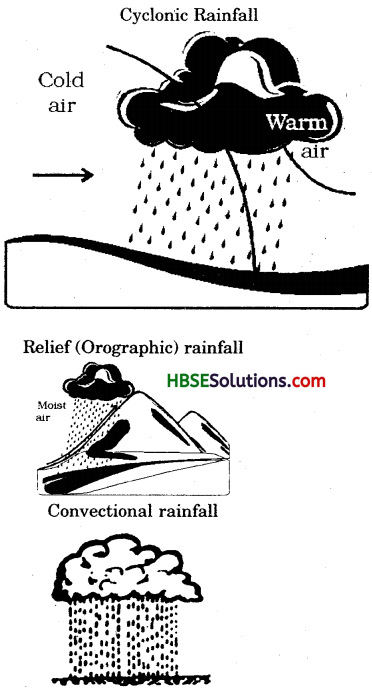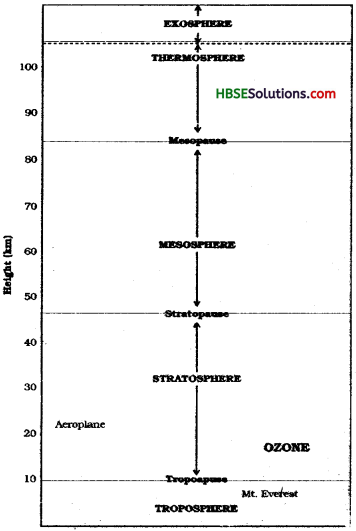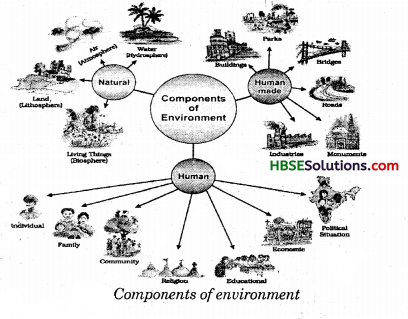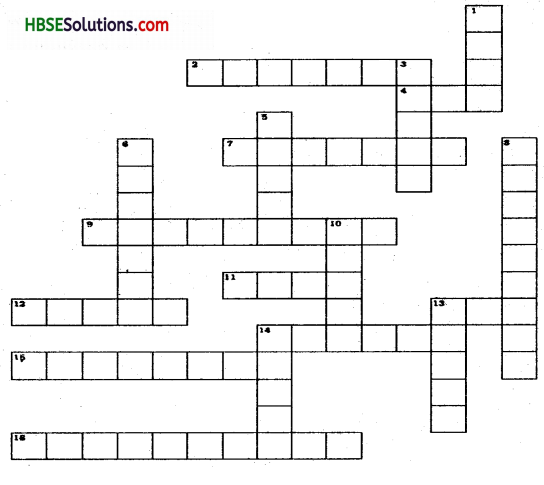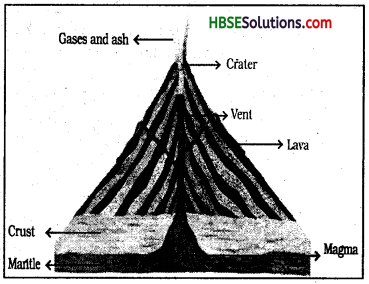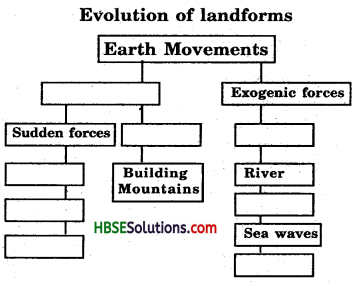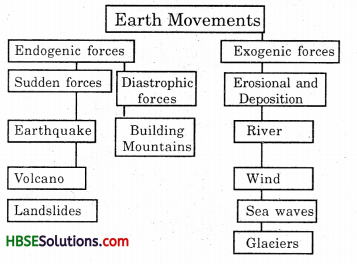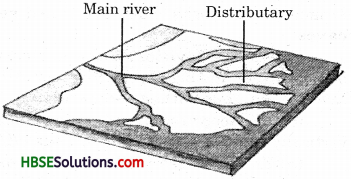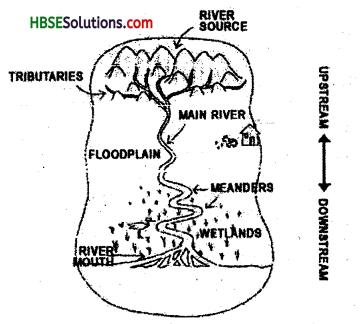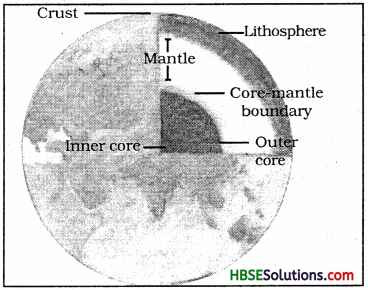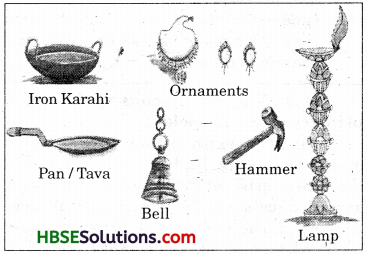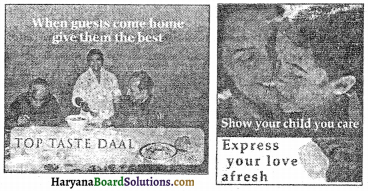Haryana State Board HBSE 7th Class Social Science Solutions Geography Chapter 6 Natural Vegetation and Wild Life Textbook Exercise Questions and Answers.
Haryana Board 7th Class Social Science Solutions Geography Chapter 6 Natural Vegetation and Wild Life
HBSE 7th Class Geography Natural Vegetation and Wild Life Textbook Questions and Answers
Class 7 Geography Chapter 6 Natural Vegetation and Wild Life Question 1.
Answer the following questions:
(i) Which are the two factors on which the growth of vegetation mostly depend?
Answer:
The growth of vegetation mostly depends on following two factors:
(ii) Which are the three broad categories of natural vegetation?
Answer:
Three broad categories of natural vegetation are as follow:
- Forests
- Grasslands
- Thorny shrubs.
(iii) Name the two hardwood trees commonly found in tropical evergreen forests.
Answer:
The two hardwood trees commonly found in tropical evergreen forests are:
- Rosewood
- Ebony
- Mahogany (Any two)
(iv) In which part of the world, tropical deciduous forest is found?
Answer:
Tropical deciduous forests are found in the large part of India, northern Australia and in Central America. Teak, sal, neem and shisham are the main trees of these forests.
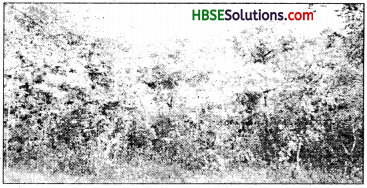
(v) In which cliiftatic condition, citrus fruits are cultivated?
Answer:
Hot dry summer and rainy mild winter season is good for the cultivation of citrus fruits.
(vi) Mention the uses of coniferous forests.
Answer:
- The wood of trees found in these forests is very soft which is used to make match box and packing boxes.
- The wood is very useful for making pulp.
- The wood is used for making news print.
- Tree helps to control soil erosion.
- Trees provide shelter to our wildlife.
(vii) In which part of the world seasonal grassland is found?
Answer:
The world seasonal grassland is found in is found in the mid-latitudinal zones and in the interior parts of the continents.

Class 7 Geography Ch 6 Natural Vegetation and Wild Life Question 2.
Tick the correct answer :
(i) Mosses and Lichens are found in :
(a) Desertic vegetation
(b) Tropical evergreen forest
(c) Tundra vegetation
Answer:
(c) Tundra vegetation
(ii) Thorny bushes are found in :
(a) Hot and humid tropical climate
(b) Hot and dry desertic climate
(c) Cold polar climate
Answer:
(b) Hot and dry desertic climate
(iii) In tropical evergreen forest, one of the common animals is :
(a) Monkey
(b) Giraffe
(c) Camel
Answer:
(a) Monkey
(iv) One important variety of coniferous forest is :
(a) Rosewood
(b) Pine
(c) Teak
Answer:
(b) Pine
(v) Steppe grassland is found in :
(a) S. Africa
(b) Australia
(c) Central
Answer:
(c) Central
Class 7th Geography Chapter 6 Natural Vegetation and Wild Life Question 3.
Match the following :
| (i) Walrus | (a) Soft wood tree |
| (ii) Cedar | (b) An animal of tropical deciduous forest |
| (iii) Olives | (c) A polar animal |
| (iv) Elephant | (d) Temperate grassland in Australia |
| (v) Campos | (e) Throny Shrubs |
| (vi) Downs | (f) A citrus fruit |
| (g) Tropical grassland of Brazil |
Answer:
| (i) Walrus | (c) A polar animal |
| (ii) Cedar | (a) Soft wood tree |
| (iii) Olives | (f) A citrus fruit |
| (iv) Elephant | (b) An animal of tropical deciduous forest |
| (v) Campos | (g) Tropical grassland of Brazil |
| (vi) Downs | (d) Temperate grassland in Australia |
Class 7th Geography Chapter 6 HBSE Question 4.
Give reasons:
(i) The animals in polar region have thick fur and thick skin.
(ii) Tropical deciduous trees shed their leaves in the dry season.
(iii) The type and thinkness of vegetation changes from place to place.
Answer:
(i) The animals in polar region have thick fur and thick skin to protect themselves from the cold climatic conditions.
(ii) Tropical deciduous trees shed their leaves in the dry season to conserve water.
(iii) The type and thickness of vegetation changes from place to place because of the variation in temperature and moisture.

Chapter 6 Natural Vegetation and Wild Life Geography Class 7 Question 5.
Activity:
(i) Collect pictures and photographs of forests and grasslands of different parts of world. Write one sentence below each picture.
(ii) Make a college of rainforest grassland and coniferous forests.
Answer:
(i) (A)
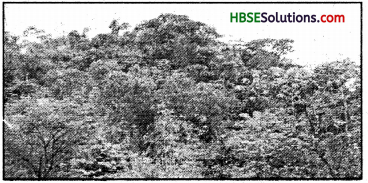
Tropical evergreen forests occur in the regions near the equator and close to the Tropics.
(B)
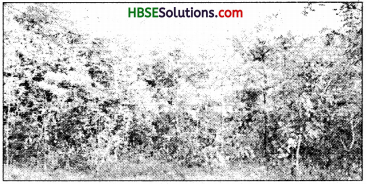
Tropical deciduous forests are the monsoon forests which experience seasonal changes.
(C)
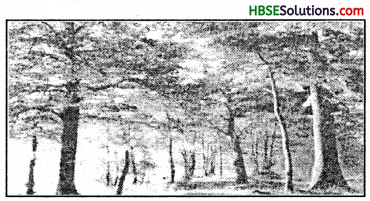
Temperate evergreen forests comprise both hard and soft wood trees like oak, pine, eucalyptus etc.
(D)
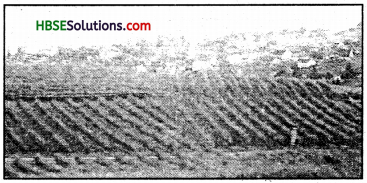
The trees of temperate deciduous forests shed their leaves in dry seasons.
(E)

Mediterranean vegetation is mostly found in the areas around the Mediterranean sea in Europe, Africa and Asia. Coniferous (Taiga) forests are found in the higher latitudes (50°-70°) of Northern hemisphere. Tropical grassland grows in the areas of moderate to low amount of rainfall.
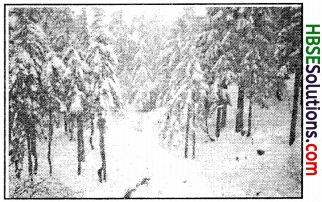
Question 6.
For Fun
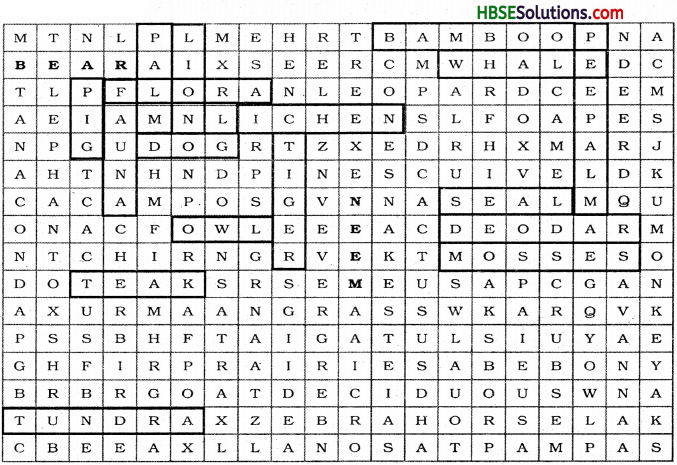
Answer:
Horizontally : Bamboo, Bear, Whale, Flora, Lichen, Hen, Pine, Seal, Fowl, Chir, Masses, Grass, Taiga, Praire, Fir, Ebony, Goat, Deciduous, Tundra, Zebra, Horse, Lianos, Pampas.
Vertically : Shrub, Ox, Pig, Cactus, Fauna, Lion, Downs, Tiger, Neem, Oak, Camel, Peepal, Oak, Deer, Savanaa, Yak.
HBSE 7th Class Geography Natural Vegetation and Wild Life Important Questions and Answers
Very Short Answer Type Questions
Question 1.
Why do the trees in tropical evergreen forests do not shed their leaves altogether?
Answer:
The trees in tropical evergreen forests do not shed their leaves’ altogether because there is no particular dry season.
Question 2.
Where are tropical deciduous forests found?
Answer:
Tropical deciduous forests are found in the large part of India, northern Australia, and in Central America.
Question 3.
What type of trees are found at higher latitudes?
Answer:
Temperate deciduous forests are found at higher latitudes.
Question 4.
What is the use of wood of coniferous trees?
Answer:
The wood of coniferous trees is used for manufacturing pulp which is used for manufacturing paper and newsprint.
Question 5.
What is the extent of tropical grasslands?
Answer:
The tropical grasslands occur on either side of the equator and extend till the Tropics.

Question 6.
What kind of grass is found in temperate grasslands?
Answer:
Short and nutritious grass is found in temperate grasslands.
Question 7.
Why is vegetation cover scarce in thorny bushes?
Answer:
Vegetation cover is scarce in thorny bushes because of scanty rain and scorching heat.
Short Answer Type Questions
Question 1.
What are the factors on which growth of vegetation depends?
Answer:
Following are the factors on which growth of vegetation depends :
- The change in height affects the character of vegetations. With the change in height, the climate changes and that changes natural vegetation.
- The growth of vegetation also depends on temperature and moisture.
- The growth of vegetation also depends on factors like slope and thickness of soil.
Question 2.
What are three categories of natural vegetation?
Answer:
The three categories of natural vegetations are :
- Forests : Forests grow where temperature and rainfall are plentiful to support a tree cover. The forests can be (i) dense forests, (ii) open forests.
- Grasslands : Grasslands include tropical and temperate grasslands. They grow in the region of moderate rain.
- Shrubs : Thorny shrubs and scrubs grow in the dry region.
Question 3.
Write a short note on temperate grasslands.
Answer:
Tropical grasslands occur oft either side of the equator and extend till the tropics. This vegetation grows in the areas of moderate’ to low amount of rainfall. The grass can grow very tall, about 3 to 4 metres in height. Savannah grasslands of Africa are of this type. Common animals found here are elephants, zebras, giraffes, deer and leopards.
Question 4.
Write three major features of tropical evergreen forests.
Answer:
Major features of tropical evergreen forests are:
These forests are so dense that thick canopies are developed which do not allow the sunlight to penetrate inside the forest. As there is no particular dry season, the trees do not shed their leaves altogether. This keeps the forest evergreen. Hardwood trees such as rosewood, ebony and mahogany are found here.
Question 5.
Where is Tundra type of vegetation found? Why?
Answer:
Tundra type of vegetation includes mosses, lichens and very small shrubs. The main polar areas of Tundra type of vegetation are Europe, Asia and North America. This is found in polar regions. They grow during the very short summer. This is so because polar regions are extremely cold and the growth of natural vegetation is very limited here.

Question 6.
What are the main features of Highlands vegetation?
Answer:
The temperature falls with the rise in the height as in the mountainous area. The factors behind the variety in the types of vegetation in highlands are the climatic changes occurring in the higher altitude.
A succession of the vegetation from the tropical to alpine types in mountains can be notice. Generally, at the foothills, there is belt of deciduous trees. The pine forests are well grown at the height between 1500 metres to 2000 metres.
Long Answer Type Questions
Question 1.
Write a note on the various’ types of grasslands.
Answer:
The various types of grasslands are:
- Tropical grasslands
- Temperate grasslands
- Thorny bushes
1. Tropical grasslands : This type of vegetation grows in the areas of moderate to low amount of rainfall. The grass here can grow very tall, about to 4 metres in height. Savannah grasslands of Africa are of this type. Common animals found here are elephants, zebras, giraffes, deer, leopards etc.
2. Temperate grasslands : This type of vegetation is found in the mid-latitudinal zones and in the interior part of the continents. Grass here is usually short and nutritious. Common animals found in this region are wild buffaloes, bisons, antilopes etc.
3. Thorny bushes : These are found in the dry desert like regions. Tropical deserts are located on the western margins of the continents, which are characterised by such vegetation. Vegetation in the polar regions is also limited. Only mosses, lichens and very small shrubs are found here. It grows during the very short summer. This is called Tundra type of vegetation. Polar animals have thick fur and thick skin which protect them from the cold climate conditions, for example, seal, walruses, musk-oxen, Arctic owl, etc.
Natural Vegetation and Wild Life Class 7 HBSE Notes
- Evergreen Vegetation : Forest with trees retaining the leaf cover across the year.
- Natural Vegetation : Original land cover of forest vegetation.
- Coniferous Trees : The forest in which trees have conical leaves and they don’t shed their leaves all at a time.
- Wildlife Sanctuary : An area, set aside for preserving its natural vegetation, natural beauty, wildlife etc.
- Biodiversity : Different species on the earth.
- Biome : A vast ecosystem with its group of plants and animals is recognised as biome.
- Eco-system : A system which comprises the physical environment and the’organisms with live therein.
- Food Chain : Food chain is the transfer of energy from one organism to another in ecological system.
- Food Web : It is complicated network of several food chains.
- Herbivores : Animals of those categories which lives on grass and plants.
- Carnivores : The animals which kill small animals for their food.
- Habitat: The physical environment in which the animals normally lives.
- Forests : Extensive area covered with trees.
- Vegetation : The assemblage of plant species living in association with each other in a given environmental framework is known as vegetation.
- Fauna : Species of animals.
- Flora : Plants of a particular region.
- Conservation : Protection, preservation and efficient utilisation of resources gifted by nature.
![]()
![]()








